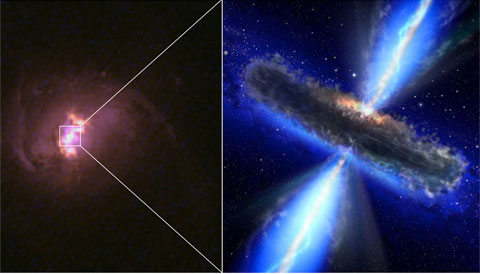The NuSTAR telescope has spied high-energy X-rays from five supermassive black holes shrouded in a thick veil of dust and gas, a test run that will lead to a better census of these hidden beasts.
It's common knowledge that quasars, powered by supermassive black holes, shine as brilliant beacons from distant corners of the universe. Except when they don't.

NASA / ESA
For awhile now, research (both theory and observations) has pointed to a population of quasars that's almost completely hidden from view, though the size of this population remains uncertain. Veiled quasars in the early universe are probably in their teenage years, in the midst of a growth spurt often brought on by a galaxy merger. Amidst the chaos of careening stars and shocked gas, the supermassive black hole gobbles its feast in secret, hidden from observers under a heavy veil of disturbed dust and gas.
But hidden quasars have been difficult to detect directly, even though measurements of their scattered radiation, seen in the universe's X-ray background, suggests there should be many. A supermassive black hole sitting in its host galaxy's core drags in surrounding gas, which heats up as it spirals into the maw and emits radiation at every wavelength from X-ray to radio. But the shroud of dust and gas blocks radiation at most wavelengths, letting through only infrared radiation (which comes from heated dust, not directly from the quasar itself) and high-energy X-rays. Even low-energy X-rays (those below 10,000 electron-volts), the type measured by X-ray telescopes XMM-Newton and Chandra, are caught in the blockade.
Enter NuSTAR, NASA's high-energy X-ray telescope that's beginning to reveal direct images of this population, capturing the X-rays that penetrate the heavy veil. In the most recent study by George Lansbury (University of Durham, UK), to be published in The Astrophysical Journal, NuSTAR turned its eye to nine objects suspected to be hidden quasars, detecting five of them at high-energy X-rays.
Of these, three were bright enough that Lansbury's team could measure the amount of material veiling each quasar. They found that previous estimates based on low-energy X-ray measurements always underestimated the amount of obscuring material. Comparing their measurements to previously published data on a total of 39 quasars, Lansbury and colleagues determined that about one in three quasars is hidden under a dusty veil.
But the team also estimated the amount of material necessary to cover those quasars that remain undetected in NuSTAR observations, and these estimates allow for a far bigger population. It could be that hidden quasars outnumber normal quasars by 3:1. Future NuSTAR observations will help complete the census and nail down the true number of these mysterious beasts.
Quasars are curious creatures. Read more about their curiosities in our Black Holes eBook, available for FREE download.
 0
0









Comments
You must be logged in to post a comment.